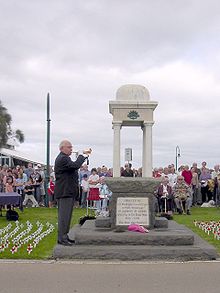ANZAC Day
The ANZAC Day (ANZAC: acronym for Australian and New Zealand Army Corps ) on April 25 is a national day of remembrance in Australia , New Zealand and Tonga . April 25, 1915 is the day of the first military action by Australian and New Zealand troops and soldiers from Tonga in World War I - the landing on Gallipoli . The Battle of Gallipoli resulted in significant casualties among Australian, New Zealand and Tongan soldiers who were led in an armed force.
Australia
On Anzac Day, parades of the Australian land forces and flight demonstrations by the air forces and other organizations as well as marches with war veterans take place in Australia . The parades will be televised. In 1935, a stamp was issued for the first time to commemorate this day. But Anzac Day is also the day on which traditional test matches of Australian football and rugby league football take place.
The holiday was officially known as ANZAC Day as early as 1916 . In the 1920s, this day became a day of remembrance for the fallen Australian soldiers of the First World War. It was a national holiday for the first time in 1927, and by the 1930s, fixed rituals had developed that continue to this day. Central locations for the commemorations are the Australian War Memorial and the ANZAC Parade in Canberra . The idea of a national museum to commemorate the Australian war victims came up as early as 1915. In 1917, the Australian War Records Section (AWRS) was established to collect records and relics.
For the national consciousness of Australia, which had only gained independence 13 years earlier, this military operation was of considerable importance and was understood as a kind of "blood sacrifice". The initial enthusiasm for the war soon waned, because the economy fell because the markets for the timber industry and raw materials in Europe collapsed, unemployment rose and inflation set in. During the war, the Australian federal government tried to introduce compulsory military service because volunteer numbers were falling. The Australians rejected the Conscription Referendum ( referendum on conscription in Australia ) in October 1916 and again in a second referendum on December 21, 1917.
Almost every tenth Australian was a soldier. Almost every fifth soldier was killed in action and almost every second was wounded. The population of Australia during the war years was approximately 4 million and the Australians provided around 330,000 soldiers, of whom 53,993 were killed in acts of war and 7,227 in non-military acts during the First World War. 137,013 Australian soldiers were wounded, 3,647 prisoners of war and 109 died in captivity. Since most of the fallen Australian soldiers were buried tens of thousands of kilometers away overseas, the thought arose in Victoria in 1915 that there should be memorials, the Avenues of Honor , for every soldier who died . to plant a tree. There are around 130 avenues of honor on mainland Australia, especially in Victoria, and around 40 in Tasmania .
Anzac Day has been criticized in Australia by the peace movement since 1960. In the 1960s and 1970s there were protests against the Vietnam War on ANZAC Day, and feminists protested in the 1980s. The significance of this day for Australia has recently been critically discussed.
New Zealand
In New Zealand , this day has been held in a similar form to that in Australia since 1920 through the Anzac Day Act . However, since the Anzac Day Act 1966, celebrations only take place in half-day form. Parades of the New Zealand Armed Forces , Police Forces, Fire Brigades and other organizations are held. 16,302 New Zealand soldiers were killed in World War I, 40,362 were wounded and 102 are missing.
Political groups also used Anzac Day in New Zealand as a day of protest, for example in 1967 when two members of the leftist Progressive Youth Movement disrupted the festive event in Christchurch and expressed their protest against the Vietnam War. There were protests in 1978 by a women's group and other similar protests in the 1980s.
Other countries
In Turkey , the day has been celebrated by the Turkish government since 1985. In other countries such as Canada , Great Britain , Germany , France , Indonesia , Thailand , Samoa , Tonga , Papua New Guinea , Korea , Japan , Ireland and Israel there are organizations and events that commemorate this day or hold events.
Web links
Individual evidence
- ↑ Patriot Act, The Australian: Information June 6, 2007 , accessed April 25, 2015
- ↑ To Alternative ANZAC Day commemoration, Peace Movement Aotearoa (PDF file; 699 kB), accessed on February 20, 2010
- ^ Conflicts: Vietnam War: Opposition to the Vietnam War . In: South Australia at War . Australian Government - Department of Veterans Affairs , accessed December 3, 2015 .
- ↑ Shane Cahill, "Don't mention the anti-war feeling," The University of Melbourne Voice Vol. 3, no. 1 ( Memento from January 7, 2011 in the Internet Archive )
- ↑ Nick Bryant, The revitalization of Anzac Day, BBC News, April 24, 2009 , accessed February 20, 2010
- ↑ A Guide to Anzac Day for New Zealanders at angac.govt.nz , accessed February 20, 2010
- ↑ Information on nzhistory.net.nz , accessed on February 20, 2010
- ^ Modern Anzac Day , New Zealand History online - Nga korero aipurangi o Aotearoa, History Group, Ministry for Culture & Heritage , Wellington, New Zealand, accessed February 20, 2010.

